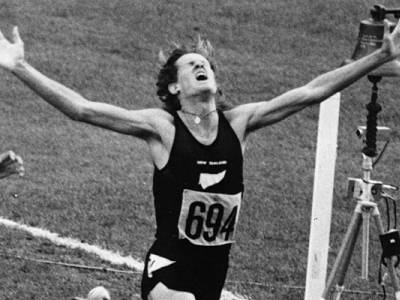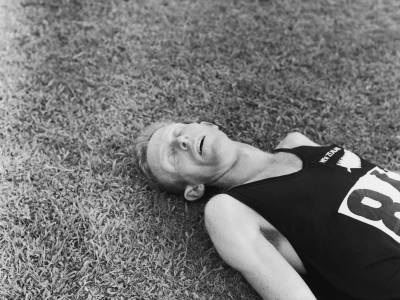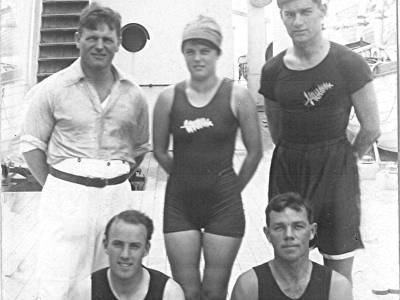Episode 2 (Read Episode 1)
The Black Singlet: Defining New Zealand athletes 1928-1948
The black singlet and silver fern were firmly entrenched as the insignia of New Zealand’s athletes by the 1928 Olympic Games in Amsterdam. In fact, black and silver had been officially recognised as the colours of New Zealand in 1927, by decree of the nation’s Olympic Council.
The 10-strong team who represented New Zealand at the Amsterdam Olympics even trained in black, on the long boat trip to England on board the SS Remuera. To while away the tedious hours at sea, and to keep in shape before the Olympics, javelin thrower Stan Lay practised by hurling potatoes into the ocean, and boxer Ted Morgan rigged up a punching bag on the ship’s deck.
Read more below
Alf Cleverley and Stan Lay on SS Remuera 1928
With training conditions far from ideal, most of the Kiwi athletes put on weight during the voyage. Morgan, in fact, was forced to box in a heavier weight class – the welterweight division - in Amsterdam. He’d also dislocated a knuckle in his explosive left hand during sparring practice when the boat arrived in England. Although the New Zealand team doctor, 1924 Olympic bronze medallist Arthur Porritt, treated Morgan’s injury, there was not a lot of time for it to heal, and it seemed as though his Olympic chances were all but knocked out.
However, Morgan came out punching in the ring. Masking the pain of his damaged hand, the Kiwi in the black singlet and shorts confidently won his first three bouts, and in the final, beat Argentine boxer Paul Landini virtually single-handed.
Morgan, the 21-year-old apprentice plumber who’d learned to box at Wellington College, became New Zealand’s first individual gold medallist.
Read more below
Ted Morgan, Norma Wilson and Stan Lay on Stanford Bridge London 1928
After the Olympics, Morgan married one of his New Zealand team-mates. In Amsterdam, 18-year-old Norma Wilson had been the first woman to run for New Zealand at an Olympic Games; 1928 was the first time female track and field athletes were allowed to participate.
Nicknamed “New Zealand’s lady flier”, Wilson was a world-class sprinter who had twice equalled the world record of 11.2 seconds over 100 yards. She was considered a medal chance at the Olympics, but an unfortunate incident in the semi-finals - where she was left on the starters blocks after another competitor broke the start - meant she missed making the final by mere centimetres.
Wilson was disadvantaged in other ways in Amsterdam. She had never run on a cinder track before, and when she returned home to a parliamentary reception, she shocked officials by urging them to lay cinder tracks in the main cities. She also beseeched them to allow New Zealand women to compete in shorts as other international athletes did.
She defiantly turned down her next invitation to run - unless she could wear short pants. “In no time, all the girls were wearing shorts,” she later said.
Read more below
The New Zealand team do the haka in the black singlet, 1932
One of the most memorable images of the black singlet is of Jack Lovelock, running toward the finish line inside Berlin’s Olympiastadion, well clear of his rivals in the final of the 1936 Olympic 1500m.
Describing it as “the most beautifully executed race of his career… an artistic creation”, Lovelock kicked away from the field with 300m remaining, and set a new world record time of 3m 47.8s. German Chancellor Adolf Hitler was amongst the 100,000 in the stands, as the Rhodes Scholar and young doctor from Timaru – dressed all in black right down to his shoes – became New Zealand’s first gold medallist on the track.
Read more belowLovelock had worn the black singlet at the 1932 Los Angeles Olympics, disappointed with his finish of seventh. But with his tumultuous victory four years later, he unwittingly began a proud Olympic tradition in New Zealand middle-distance running. One who would be inspired by him, and eventually follow him on to the Olympic dais, was Rod Dixon, the bronze medallist in the 1972 Munich 1500m final.
“The most powerful image of the black singlet for me is Jack Lovelock in 1936,” Dixon says.
“A simple white fern between a white NZ on a black background. To me, it’s a pretty powerful statement."
The year before Lovelock tragically died in the New York subway in 1949, he passed on his Olympic knowledge to Doug Harris – New Zealand’s 800m runner at the next Olympic Games, in London 1948.
A favourite to win a medal, the powerful Harris had nothing but bad luck on the track in Wembley Stadium. In his heat, he was spiked by a Danish runner, leaving him in agonising pain. He managed one lap of the semi-final when his left Achilles tendon suddenly snapped, and he was carried away from the track in tears.
It was a challenging Olympics for all seven members of the team. It was the only time a New Zealand team would leave an Olympics medal-less, and the last time a Kiwi team would travel by sea.
Dunedin backstroke swimmer Ngaire Lane, accompanied by a chaperone as New Zealand’s only female athlete, struggled to train on the five-week voyage. But the ship’s carpenter built her an oblong box barely two metres long, lined it with canvas and filled it with seawater each day. “It was barely a foot longer than me. I could only lie on my back and kick,” Lane said.
Read more belowRacing in her black swimsuit, Lane finished 11th in the 100m backstroke, but won a bronze medal in the Australasian relay team in a gala event held during the Olympics. At 90 years of age, Ngaire Galloway is New Zealand’s oldest surviving Olympian.
The dashing outfit worn by the 1948 team – with its black blazer and white piping – inspired the dress uniform of the New Zealand team for the 2012 London Games.

The 1948 and 2012 NZ Olympic blazer
Tweet Share



